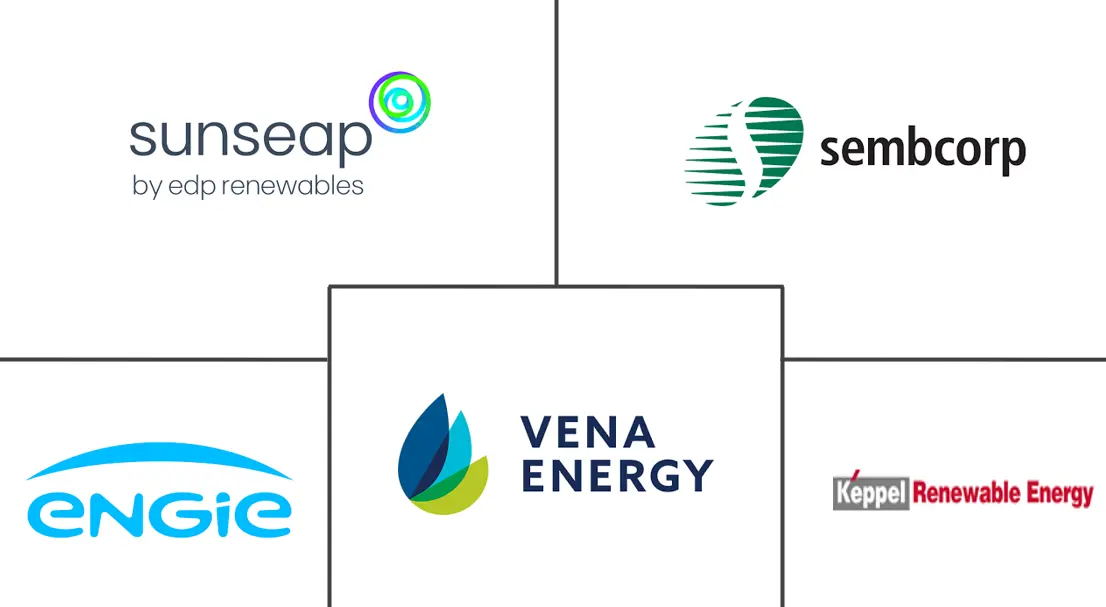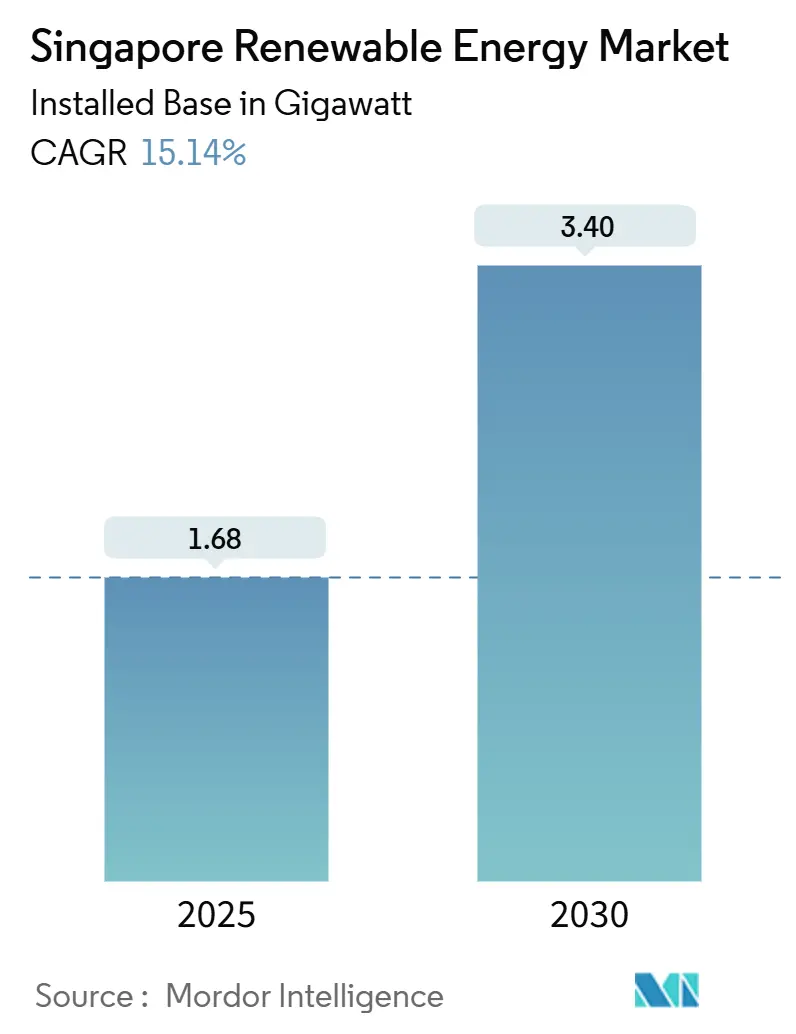
Singapore Renewable Energy Market Analysis by Mordor Intelligence
The Singapore Renewable Energy Market size in terms of installed base is expected to grow from 1.68 gigawatt in 2025 to 3.40 gigawatt by 2030, at a CAGR of 15.14% during the forecast period (2025-2030).
Rising corporate demand for clean electricity, stringent net-zero rules, and region-wide power import plans are accelerating investment. Solar keeps its dominant role because rooftop, floating, and near-shore deployments are the most space-efficient options in a city-state with only 728 sq km of land. The roll-out of Southeast Asia’s largest 285 MWh battery system, together with a solar forecasting model funded by SGD 6.2 million in R&D grants, shows how grid operators are tackling intermittency. Regional import targets of 6 GW by 2035 add supply diversity while anchoring Singapore’s position as a cross-border clean-power hub. Intensifying sustainability mandates in the fast-growing data-center cluster further lifts long-term electricity offtake certainty for project developers.
Key Report Takeaways
- By technology, solar captured 84.2% of the Singapore renewable energy market share in 2024, while registering the fastest forecast CAGR at 15.7% through 2030.
- By end-user, utilities held 64.9% of the Singapore renewable energy market size in 2024; C&I demand is expanding at a 17.3% CAGR to 2030.
Singapore Renewable Energy Market Trends and Insights
Drivers Impact Analysis
| Driver | (~) % Impact on CAGR Forecast | Geographic Relevance | Impact Timeline |
|---|---|---|---|
| Net-zero 2050 & Green Plan 2030 targets intensifying renewable build-out | +4.20% | National, with concentration in central and western reservoir zones | Long term (≥ 4 years) |
| Declining solar-PV CAPEX amid high rooftop irradiance | +3.80% | National, particularly industrial estates and public housing clusters | Medium term (2-4 years) |
| Corporate sustainability pledges pushing onsite solar PPAs | +3.10% | National, with early adoption in central business district and Jurong industrial zone | Short term (≤ 2 years) |
| Rapid roll-out of floating PV on inland reservoirs | +2.60% | Tengeh, Bedok, Pandan, Lower Seletar reservoir catchments | Medium term (2-4 years) |
| Agrivoltaic pilots unlocking dual-use of scarce land | +0.50% | Limited to Kranji and Lim Chu Kang agricultural zones | Long term (≥ 4 years) |
| Surge in REC demand from hyperscale data-centre boom | +2.90% | National, concentrated in data-center clusters | Short term (≤ 2 years) |
| Source: Mordor Intelligence | |||
Net-zero 2050 & Green Plan 2030 targets intensifying renewable build-out
Singapore’s legally binding net-zero target for 2050 and its updated goal of 45-50 million tCO₂e by 2035 create an unambiguous demand signal. A USD 1 billion hydrogen-ready power plant with carbon-capture features reached final investment decision right after the February 2025 policy update.[1]Carbon Herald, “Singapore Bets USD 1B on Hydrogen-Ready Plant,” carbonherald.com New generation units must now be at least 30% hydrogen-ready, forcing technology upgrades that favor renewable hybrids. The Energy Market Authority (EMA) has embedded emissions-based bidding criteria into its electricity market, tightening the cost of carbon-intensive output. Clear accountability mechanisms from the National Climate Change Secretariat have moved renewables from an optional efficiency gain to a compliance necessity. Long lead-time assets, such as floating solar or utility-scale storage, therefore secure faster permitting and cheaper green financing in the Singapore renewable energy market.
Declining solar-PV CAPEX amid high rooftop irradiance
Capital costs for Tier-1 modules fell another 7% between 2024 and 2025, intersecting with Singapore’s steady 1,700 kWh/m² annual irradiance to sharpen project economics.[2]Energy Market Authority, “Singapore Energy Statistics 2025,” ema.gov.sg The government refrains from feed-in tariffs; instead, simplified credit schemes let owners sell excess power without bureaucratic delay. Private sector players delivered 63.5% of new capacity in 2024, proving that pure cost competitiveness now drives uptake. Solar forecasting linked to advanced weather analytics has trimmed balancing charges, lifting internal rates of return. With rooftop leases structured around 15- to 20-year payback horizons, commercial landlords increasingly treat photovoltaics as a core infrastructure upgrade rather than an ESG add-on in the Singapore renewable energy market.
Corporate sustainability pledges pushing onsite solar PPAs
Hyperscale data-center operators, multinationals, and local conglomerates have moved beyond certificates toward physical PPAs. STT GDC sourced 52% of its 2024 electricity from renewables and secured SGD 2.5 billion in green financing facilities. Sembcorp’s 18-year deal to supply 75 MW of solar generation to Equinix illustrates appetite for tenor-matched contracts that hedge utility bills and reputational risk. Backup-generator fleets are shifting to renewable diesel blends, lowering Scope 1 emissions without altering mission-critical uptime. Corporates are keen on visible rooftop arrays because they double as brand statements in the dense Singapore skyline. The PPA boom adds predictable offtake that underpins debt service for new capacity, reinforcing the growth trajectory of the Singapore renewable energy market.
Rapid roll-out of floating PV on inland reservoirs
The 60 MWp Tengeh Reservoir array occupies 45 ha yet powers five water-treatment plants, showcasing dual-use land optimisation. Evaporative cooling lifts panel efficiency by around 11%, offsetting tropical temperature losses.[3]ABB, “Cooling Effect Boosts Floating PV Yield,” new.abb.com Public Utilities Board (PUB) plans further arrays across Kranji and Pandan reservoirs to help meet the 2 GWp solar target by 2030. EDP Renewables’ 5 MWp system in the Straits of Johor indicates viable near-shore extensions. Singapore’s memorandum with Indonesia for a 2 GW floating-solar-plus-battery complex in Batam will funnel surplus output back through subsea cables, demonstrating regional scalability for the Singapore renewable energy market.
Restraints Impact Analysis
| Restraint | (~) % Impact on CAGR Forecast | Geographic Relevance | Impact Timeline |
|---|---|---|---|
| Severe land scarcity for utility-scale assets | -2.80% | National, acute in eastern and northern land-use zones | Long term (≥ 4 years) |
| Intermittency & grid-stability challenges in a dense network | -1.90% | National, concentrated stress in central grid nodes | Medium term (2-4 years) |
| Competition from low-carbon power imports under LTMS-P | -1.60% | National, with import terminals in western Tuas and Jurong zones | Medium term (2-4 years) |
| Limited biomass feedstock after waste-to-energy prioritisation | -0.40% | National, constrained by incineration plant capacity | Long term (≥ 4 years) |
| Source: Mordor Intelligence | |||
Severe land scarcity for utility-scale assets
Only 23% of Singapore’s surface is zoned for industrial or infrastructure use, constraining ground-mount projects. Developers request longer land-lease tenures to match 25-year asset lives, but state agencies often grant parcels for 15 years or less. The UNFCCC label of “alternative-energy-disadvantaged” underscores structural limits. Innovations such as vertical bifacial arrays on building façades and car-park canopy systems squeeze power into overlooked surfaces, yet aggregate contribution remains modest. Therefore, policy pivots to regional imports and floating solar maintains growth momentum in the Singapore renewable energy market.
Intermittency & grid-stability challenges in a dense network
Solar ramps of ±100 MW within minutes stress a tightly meshed 230 kV grid serving 5.9 million residents. EMA’s forecasting tool, co-developed with the National University of Singapore, narrows the mean-absolute-error to 6%, aiding dispatch planning. A 285 MWh lithium-iron-phosphate system offers two-hour buffering, but system studies suggest at least 1 GWh will be required by 2030 as variable renewables climb. Smart-grid pilots in Punggol District employ real-time load curtailment across IoT-connected buildings to smooth peaks. Scaling these solutions remains capital-intensive and may temper growth in the Singapore renewable energy market.
Segment Analysis
By Technology: Solar Dominance Amid Niche Alternatives
Solar supplied 84.2% of 2024 capacity and is tracking a 15.7% CAGR to 2030, cementing its role as the backbone of the Singapore renewable energy market. Floating arrays on Tengeh, Bedok, and Pandan reservoirs alone unlock more than 200 MW that would otherwise require 150-200 ha of scarce land. Roof-mounted systems dominate industrial estates, leveraging 1,580 kWh/m² irradiance and bifacial modules to deliver sub-grid pricing to factories and data centers. Wind remains marginal given 2-3 m/s average speeds and crowded coastal waters, while domestic hydropower is nonexistent due to flat topography. Waste-to-energy plants add 150 MW of bioenergy, capturing 3 M t of municipal waste and reducing landfill reliance. Geothermal and ocean energy sit in the research phase, hindered by low thermal gradients and minimal tidal ranges.
The Singapore renewable energy market share outside solar is therefore shaped by necessity rather than optional diversification. Hydropower imports from Laos supply 100 MW under a 25-year PPA; future links could arrive from Cambodia and Vietnam via the Low-Carbon Energy Imports Scheme. Building-integrated photovoltaics are gaining traction in marquee developments such as Marina Bay Sands, where façade-mounted systems meet Green Mark mandates. Collectively, non-solar technologies will retain a sub-20% share of installed capacity through 2030.
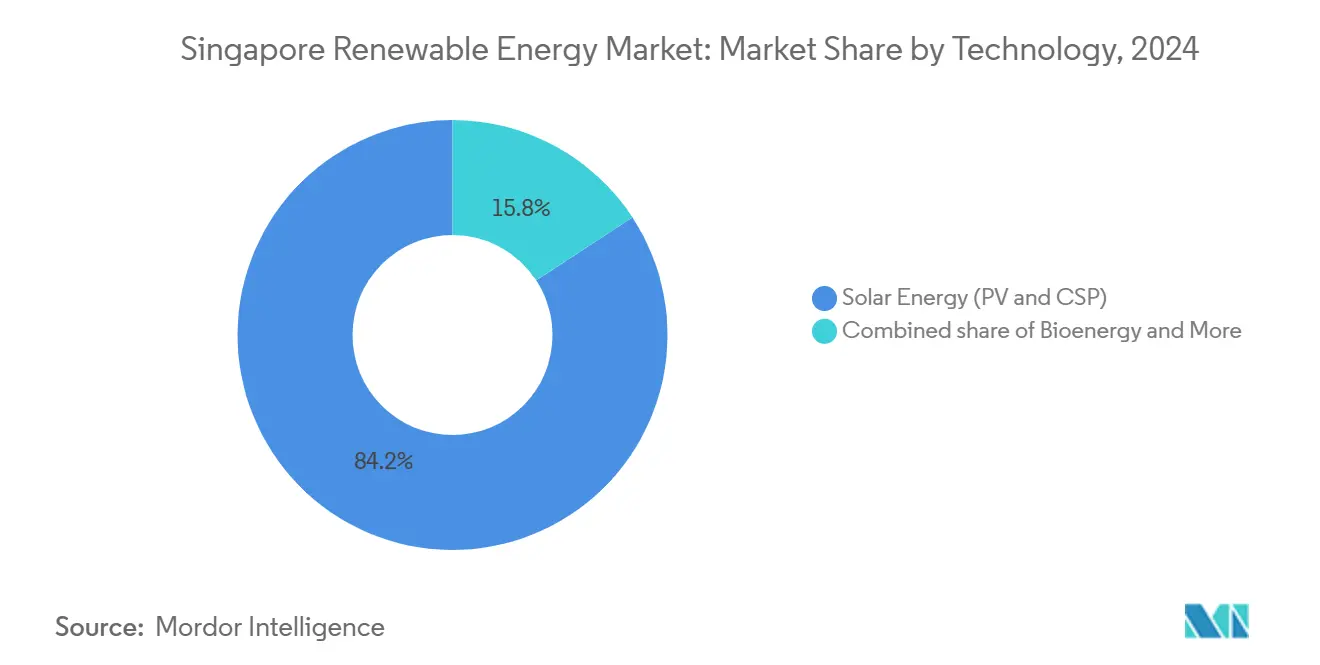
Note: Segment shares of all individual segments available upon report purchase
By End-User: Utilities Lead, C&I Accelerates
Utilities owned 64.9% of installed capacity in 2024, anchored by Sembcorp's 250+ MW solar-plus-waste-to-energy fleet and Keppel's reservoir projects. These incumbents sign 20-25-year utility-scale PPAs with SP Group or sell directly into the National Electricity Market, securing the bulk of Singapore's renewable energy market for at least the next five years. However, the 17.3% CAGR expected in the C&I space indicates structural change. Data-center operators must procure RECs for 100% of consumption by 2030, catalyzing rooftop PPAs across Jurong and Tuas. Pharmaceutical, semiconductor, and logistics tenants now view solar as a hedge against rising carbon taxes, which step up from SGD 45/tCO₂e in 2026-27 to SGD 50-80 by 2030.
Residential uptake is slower because split incentives dilute payback, although SolarNova aggregates demand for 1,075 public-housing blocks under Phase 8. REIT-led portfolios are flipping this equation by embedding solar into lease contracts, giving landlords a new revenue stream and tenants immediate savings. As licensing timelines have fallen to roughly three months for sub-1 MWp rooftop systems, smaller C&I buyers can now enter the Singapore renewable energy market with limited administrative friction.
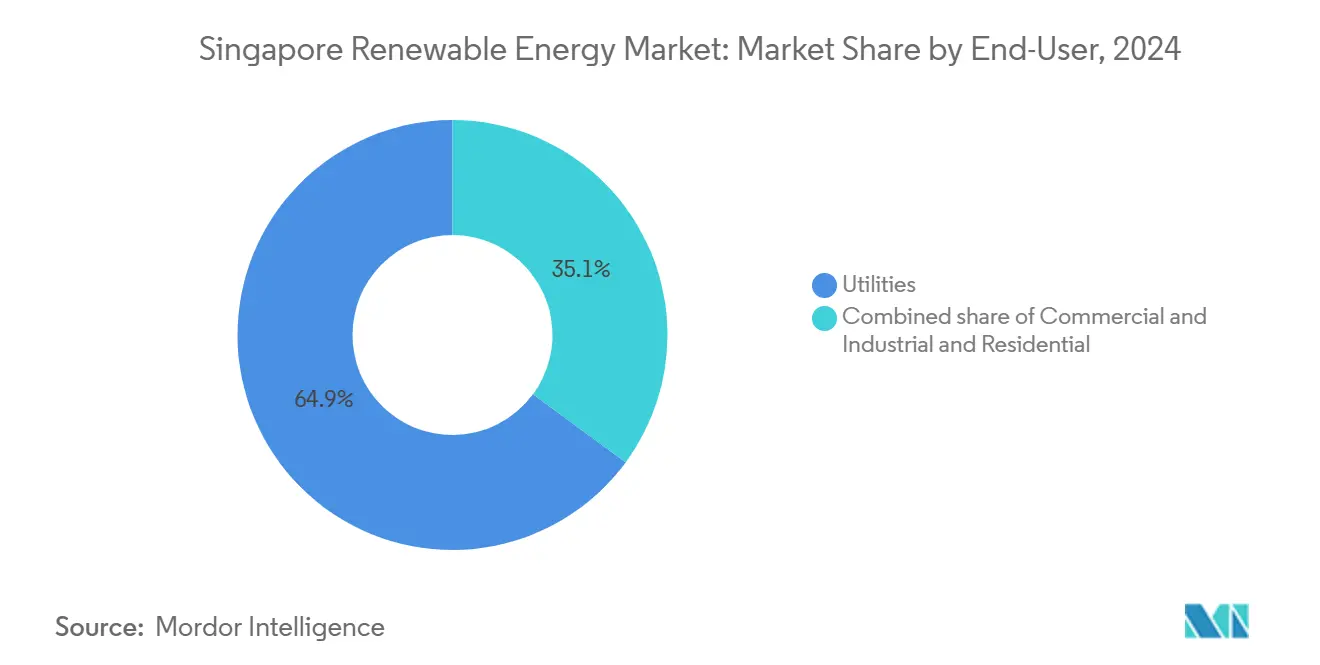
Note: Segment shares of all individual segments available upon report purchase
Geography Analysis
Singapore’s compact 728 sq km footprint forces a dual-track strategy of maximising every domestic surface while importing renewable electrons. Floating arrays on reservoirs, vertical façades, and car-park canopies are mapped through a national geospatial solar calculator maintained by EMA. The tool prioritises installations near substations to cut cabling costs, boosting overall project economics within the Singapore renewable energy market.
High solar irradiance throughout the equatorial belt, stable diurnal profiles, and minimal seasonal swings simplify generation forecasting. Coupled with aggressive energy-efficiency codes for buildings, this climate advantage lets peak-hour solar offset midday air-conditioning demand. Dense data-centre clusters in Tai Seng and Jurong see tailored PPA packages that blend rooftop supply with imported power to meet stringent uptime rules. These localised demand nodal points shape grid-reinforcement budgets and guide storage placement.
Regionally, the island functions as a clean-energy node under ASEAN’s LTMS-P framework. Indonesia will deliver 2 GW of solar-plus-battery power via subsea cables by 2030, Cambodia 1 GW of hydro-backed solar, and Vietnam 1.2 GW from offshore wind-solar hybrids. Imports equal roughly 30% of the projected 2035 load, mitigating domestic land scarcity. Interconnector capacity upgrades at the Senoko and Jurong terminals are scheduled to dovetail with new synchronous condensers, preserving stability as the Singapore renewable energy market integrates variable regional supply.
Competitive Landscape
Competition is moderate, with the top five players holding around 55% of installed capacity. Sembcorp posted SGD 183 million in renewable earnings during 2024 after diversifying into regional solar farms and urban micro-grids.[4]Asian Power, “Sembcorp FY24 Results,” asian-power.com Keppel Infrastructure Trust broadened its base through a 45% stake in European solar assets while advancing a local hydrogen-ready plant, signalling an integrated generation-to-trading model. EDP Renewables commands more than 30% of installed solar, leveraging floating expertise for moat creation in the Singapore renewable energy market.
Strategic alliances shape market entry. Keppel teamed with Huawei on solar-plus-battery projects targeting ASEAN grids, marrying digital optimisation with asset ownership. Vena Energy secured conditional approval to export 400 MW from Riau Islands, banking on cross-border competency. Sembcorp and TotalEnergies are exploring green-hydrogen logistics, aiming to blend molecules into Jurong Island’s petrochemical cluster.
Innovation remains a key differentiator. VFlowTech closed USD 20.5 million to expand flow-battery output, promising 12-hour storage useful for capturing off-peak import surpluses. Shell’s divestment of its Energy and Chemicals Park introduces room for new renewable retrofits. SP Group’s takeover of Thai solar portfolios signals outbound ambitions. As more regional players eye Singapore, technology, financing, agility, and proven execution will decide share gains in the Singapore renewable energy market.
Singapore Renewable Energy Industry Leaders
-
EDPR Sunseap
-
Sembcorp Industries
-
Keppel Renewable Energy
-
Vena Energy
-
ENGIE Southeast Asia
- *Disclaimer: Major Players sorted in no particular order
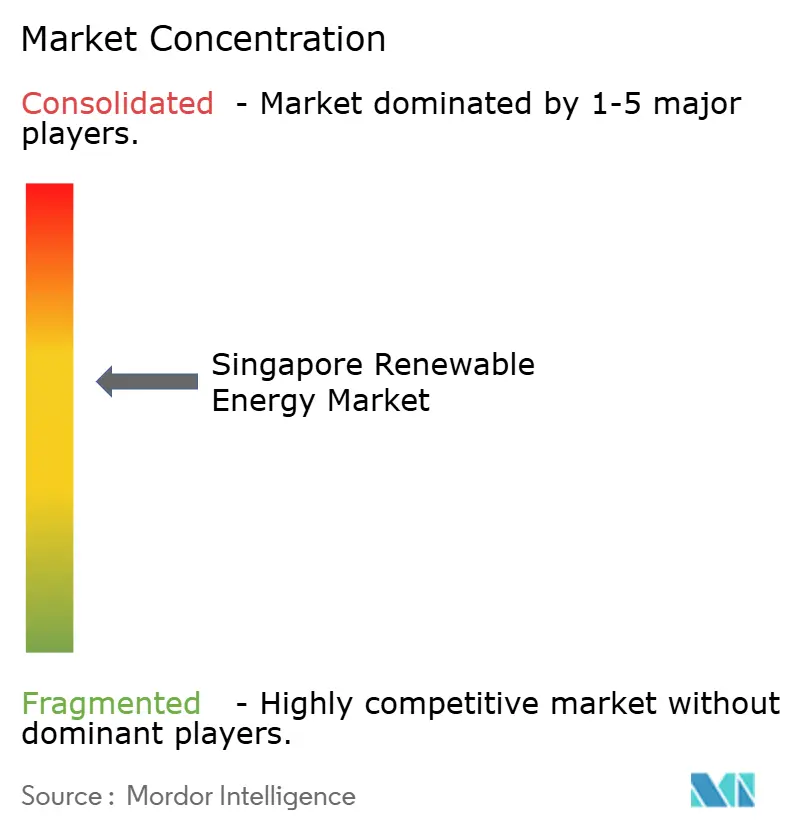
Recent Industry Developments
- June 2025: Nouryon inked a long-term deal and successfully launched rooftop solar photovoltaic (PV) systems at its two production sites on Jurong Island, Singapore. EDP Renewables APAC (EDP) spearheaded the development and installation of these systems.
- May 2025: EMA granted conditional approval to a TotalEnergies-RGE JV for a subsea link importing Indonesian clean power. The project involves a hybrid renewable power plant in Indonesia's Riau Province, combining solar power generation with a Battery Energy Storage System (BESS).
- May 2025: Keppel partnered with Huawei to co-develop solar PV and battery systems across ASEAN grids. The partnership aims to design and develop solutions for interconnected power grids, low-carbon data centers, industrial parks, and hybrid energy systems.
- November 2024: SP Group (SP) has acquired solar photovoltaic (PV) assets in Thailand, boasting a total capacity of 13 megawatt-peak (MWp). This acquisition not only marks SP's inaugural foray into mergers and acquisitions (M&A) in Thailand but also underscores the company's dedication to bolstering the nation's renewable energy and sustainability objectives.
Singapore Renewable Energy Market Report Scope
Renewable energy is derived from natural sources that replenish faster than they are consumed, such as sunlight, wind, water, geothermal heat, and biomass. These resources are considered inexhaustible and are used to generate electricity, heat, and fuel, typically resulting in a lower carbon footprint and reduced environmental impact compared to fossil fuels.
The Singapore Renewable Energy Market is segmented by technology and end-user. By technology, the market is segmented by Solar Energy (PV and CSP), Wind Energy (Onshore and Offshore), Hydropower (Small, Large, PSH), Bioenergy, Geothermal, Ocean Energy (Tidal and Wave). By end user, the market is segmented into Utilities, Commercial and Industrial, and Residential. The report also covers the market size and forecasts for Singapore.
For each segment, the market sizing and forecasts have been done based on the installed capacity (GW).
| Solar Energy (PV and CSP) |
| Wind Energy (Onshore and Offshore) |
| Hydropower (Small, Large, PSH) |
| Bioenergy |
| Geothermal |
| Ocean Energy (Tidal and Wave) |
| Utilities |
| Commercial and Industrial |
| Residential |
| By Technology | Solar Energy (PV and CSP) |
| Wind Energy (Onshore and Offshore) | |
| Hydropower (Small, Large, PSH) | |
| Bioenergy | |
| Geothermal | |
| Ocean Energy (Tidal and Wave) | |
| By End-User | Utilities |
| Commercial and Industrial | |
| Residential |
Key Questions Answered in the Report
How fast is capacity expected to grow by 2030?
Total capacity is forecast to hit 3.4 GW by 2030, growing from 1.68 GW in 2025, equal to a 15.14% CAGR over 2025-2030.
Why does solar dominate Singapore’s clean-power mix?
High rooftop irradiance, floating reservoir projects, and supportive rooftop mandates make solar the most economical and scalable option.
What role will imported electricity play?
EMA targets 6 GW of low-carbon imports by 2035 to complement limited domestic resources and enhance grid reliability.
How are corporate buyers participating?
Multinationals and REITs sign 15-20-year onsite PPAs, securing electricity below grid rates and accruing renewable energy certificates.
Which technologies help manage solar intermittency?
Fast-frequency reserves, machine-learning solar forecasting, and utility-scale battery storage smooth output and maintain grid stability.
Page last updated on:
